Rosy Red Cheeks? 17 Surprising Causes & Treatments for Redness
Why Are My Cheeks Always Red? Exploring 17 Reasons for Rosy Facial Skin
The Complete Guide from Acne to Rosacea!
Hey there, gorgeous! Are you wondering why your cheeks sometimes get flushed or are consistently red? The most common reasons for flushing are fever, hyperthermia, menopause, and… ROSACEA!!!1 This complete list will uncover the secrets behind this common phenomenon and all of the varying causes of your facial redness.
What causes red cheeks?
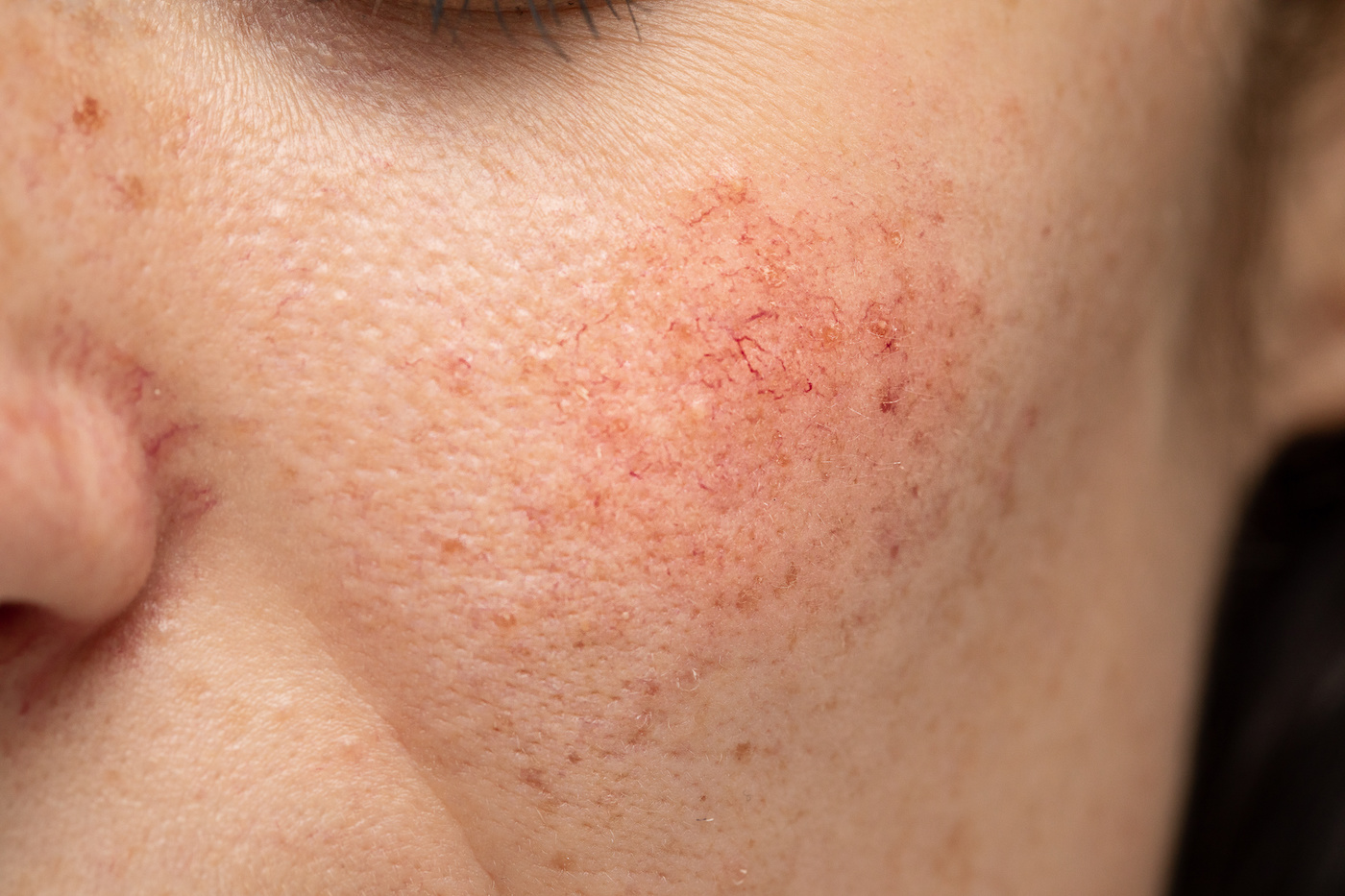
Red cheeks can be a sign of youth and good health, but they might also indicate rosacea, acne, or other more serious illnesses. Some of these conditions cause blood vessels to widen near the skin’s surface, leading to a flushed appearance.
While the redness is often a natural response to elements like cold weather or spicy foods, understanding your specific concern is key to managing and treating your red cheeks effectively.
Get ready to discover the
Key Takeaways
- It’s important to see a
doctor iffacial redness persists - Address facial redness early on to manage symptoms and potentially reverse your condition

17 Common Causes For Your Facial Redness
1. Rosacea
Rosacea is a common skin condition. It can affect anyone, but its causes vary from person to person. Risk factors include:
- age: 30-50 years old
- family history of rosacea (likely subtype1: Erythmatotelangiectatic rosacea)F
- sun sensitivity
- light skin, light eyes
- history of smoking
- gut microbiome imbalances
Rosacea Symptoms
Rosacea causes red, flushed cheeks and increased sensitivity to the face. There are four types of rosacea, each with unique symptoms like:
- visible blood vessels
- acne-like bumps
- skin thickening
- flushing or redness of the face
- eye inflammation
- burning sensation
Managing rosacea can be challenging, but with proper care and support, it’s possible to find relief and improve your skin health.
Rosacea Treatment
If you think your red cheeks might be due to rosacea, follow these steps:
- Consult a dermatologist for an accurate diagnosis.
- Distinguishing rosacea from other conditions like eczema or lupus is vital.
- Focus on long-term prevention through lifestyle changes.
- Understanding rosacea’s underlying causes is key. Gut health and rosacea go hand in hand. And while there’s currently no pharmaceutical cure, you can often manage your symptoms with diet and lifestyle modifications or take steps to reverse rosacea naturally. This involves uncovering your specific rosacea triggers and incorporating a rosacea diet to reduce inflammatory foods and flare-ups.
2. Acne
Acne is a skin condition that affects many people. Symptoms on the cheeks are often caused by hormonal changes or clogged pores.
Acne Symptoms
Symptoms can appear as red, inflamed bumps, or pimples. Some people may also have oily skin or blackheads and whiteheads. These blemishes may painful cysts, itching, or a burning sensation.
Acne and rosacea are commonly confused with one another as both can cause facial redness and bumps. However, acne redness is usually limited to pimples, whereas rosacea causes more widespread cheek and facial redness. While acne often appears on the chest, back, and shoulders, rosacea less frequently affects these areas and is primarily facial.
Acne Treatment
If you have red cheeks due to acne, it’s important to understand the symptoms and available treatments, such as washing your face regularly, using gentle products, and seeking advice from a dermatologist.
Treatment: There are various options available to treat facial acne. These include over-the-counter skincare like creams, gels, or cleansers with ingredients like Benzoyl Peroxide or Salicylic Acid. In severe cases, a dermatologist may prescribe oral medications or topical treatments such as retinoids or antibiotics. It’s crucial to follow a consistent self-care routine and avoid popping or picking at the pimples to prevent scarring.

Autoimmune Disorders
An autoimmune disorder is when your body’s immune system attacks and destroys its own healthy body tissue by mistake.
There are about 80 autoimmune disorders, but only a few common ones affect your skin and cause red cheeks:
- Eczema
- Lupus
- Psoriasis
3. Eczema (Atopic Dermatitis)
Now, let’s focus on the red cheeks that come with this atopic dermatitis, or eczema.
Eczema Symptoms
When you have eczema on your face, it’s common to have red cheeks. Your cheeks might:
- Look red
- Look inflamed
- Feel dry, itchy, and irritated
Addressing these symptoms quickly is important to avoid more discomfort and potential problems.
Eczema Treatment
Treating facial eczema involves a few key steps:
- Identify and avoid triggers like certain skincare products, allergens, foods, or environmental irritants.
- Use gentle cleansers and moisturizers designed to soothe and hydrate sensitive skin. Dermatologist-prescribed creams or ointments may be needed to reduce inflammation and control symptoms. In severe cases, your doctor might suggest oral medications or light therapy.
Pros of Treatment:
- Soothes and hydrates the skin.
- Reduces inflammation and manages symptoms.
- Aids healing and prevents further discomfort.
Cons of Treatment:
- Some products may aggravate eczema.
- Oral medications could have side effects like high blood pressure or gastrointestinal issues.
- Light therapy may require multiple sessions for effectiveness and often can make symptoms worse.
4. Lupus
The second autoimmune disorder that can cause redness on the cheeks is Lupus. The cause of lupus is still unknown, and researchers are still trying to learn what may trigger or lead to the disease.
Lupus Symptoms
Lupus, an autoimmune disorder, often presents a “butterfly rash” on the cheeks and nose. This rash, resembling a butterfly shape, causes facial redness and flushing, signaling an underlying autoimmune disease. Recognizing lupus symptoms is crucial for effective management.
Lupus Treatment
If you see persistent redness on your face, it’s important to see a healthcare provider to get an accurate diagnosis. The treatment options for red cheeks in Lupus aim to reduce inflammation and manage symptoms. These may include using creams on the skin, taking oral medications, and making lifestyle changes to minimize triggers.
It’s crucial to work closely with a dermatologist or healthcare professional to create a personalized treatment plan that addresses your specific needs and ensures your safety.
5. Psoriasis
Psoriasis Symptoms
Psoriasis is a condition that causes the skin cells to grow too quickly, resulting in raised, scaly patches. When psoriasis affects the face, it can cause redness and discomfort.
While there’s no cure for Psoriasis, treatments are available to improve the skin’s condition.
Psoriasis Treatment
Psoriasis on the face, causing redness and scaly patches, requires a personalized treatment plan based on severity and individual factors.
Key considerations include assessing the condition’s severity to determine suitable treatments, differentiating it from rosacea, and creating a holistic plan that may involve dietary changes, lifestyle adjustments, and gentle skincare routines. A proper understanding of these aspects is essential for effective psoriasis management.
6. Reaction from Medication (Drug Allergy)
Drug Allergy Symptoms
Sometimes, medications can cause allergic reactions, which can result in symptoms like redness, rashes, and itching on the face.
It’s important to be aware of these possible side effects and consult a healthcare professional if you experience any concerning symptoms after starting a new medication.
Drug Allergy Treatment
If you think your red cheeks are due to a drug allergy, it’s crucial to seek medical help. Your doctor can determine the cause of the reaction and provide appropriate treatment. This may involve stopping the medication and offering alternative options.
7. Spider Veins (Telangiectasias)
Spider Vein Symptoms
Spider veins, also known as Telangiectasias, are small blood vessels that become dilated and appear close to the surface of the skin. These veins can create a pattern that looks like a web and make the cheeks look flushed.
While spider veins are usually not harmful, they can be a cosmetic concern for some people. Telangiectasias often occurs in later stages of rosacea and for some, this is the first indication of a medical condition versus skin sensitivity.
Spider Vein Treatment
Here are three important things to know about spider veins and how to treat them:
- Spider veins can be a sign of rosacea, a long-term skin condition that causes facial flushing and redness. If you have red cheeks, rash, or facial flushing, it could be a sign of rosacea.
Treatment options for spider veins include:
- Sclerotherapy
- Laser therapy
- Radiofrequency therapy
These procedures help to collapse and close off the affected blood vessels, reducing the appearance of redness.
It’s important to see a certified dermatologist for the right diagnosis and treatment plan.
8. Shingles
Shingles is a painful rash caused by the same virus (varicella-zoster) that causes chickenpox.
Shingles Symptoms
When this virus becomes active again, it can affect the nerves and lead to a rash that makes the cheeks red and forms blisters.
Shingles Treatment
Shingles on the face can lead to red cheeks, with treatment varying based on the infection’s severity. Typically, antiviral medications are prescribed to reduce severity and duration.
Pain can be managed with over-the-counter remedies and topical creams. Keeping the area clean and avoiding scratching is crucial to prevent complications.
9. Menopause Hot Flashes
In menopause, reduced estrogen can disrupt body heat regulation, causing hot flashes and facial flushing. Climacterium, (menopause and the bodily and psychological changes that accompany it) can affect 50% to 85% of women, and is another common reason for flushing during natural menopause.2
Hot Flash Symptoms
Hot flashes are a temporary yet common symptom of menopause that can also make your face turn red. When hot flashes happen, you can experience one or all of the following symptoms:
- Feeling intense heat in your face
- Suddenly turning red and flushing
- Increased heart rate and sweating
Hot Flash Treatment
If you’re experiencing red cheeks in addition to menopause hot flashes, here are some important signs to watch out for and ways to treat them:
- Stay cool: Wear layers and use a fan to control your body temperature.
- Avoid triggers: Spicy foods, smoking, alcohol, hot drinks, and showers at extreme temperatures can make hot flashes worse.
- Relaxation techniques: Deep breathing exercises and meditation might help manage the symptoms.
10. Pregnancy Facial Redness
Pregnancy Facial Redness Symptoms
Pregnancy is a beautiful journey that is filled with many hormonal changes, and one of these changes may result in redness on the face.
This phenomenon can be attributed to hormonal fluctuations and increased blood flow.
Pregnancy Facial Redness Treatment
Experiencing red cheeks during pregnancy calls for gentle care:
- Stick to a gentle skincare routine with products suitable for sensitive skin
- Steer clear of harsh chemicals and limit sun exposure to prevent worsening redness
- Use cold compresses or soothing creams to reduce inflammation
- For safe topical treatments, consulting a dermatologist is advisable
Each pregnancy is unique, so it’s important to seek personalized advice from a healthcare professional.

Common Causes of Red Cheeks in Children
Many parents often notice “chapped cheeks” in children, with several common causes, including facial eczema or even rosacea.
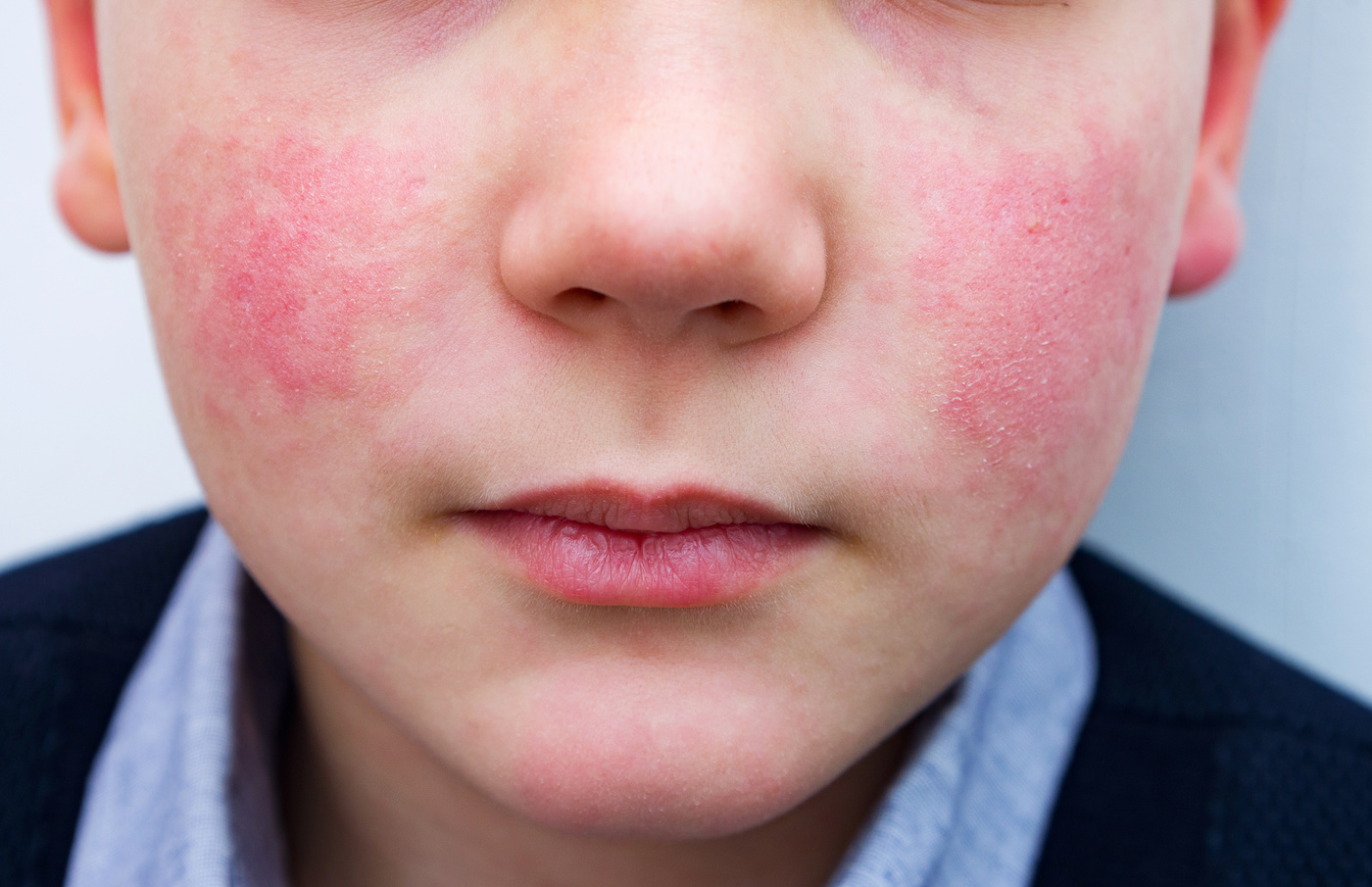
If your child has persistent cheek redness, it’s important to consult a healthcare professional for a proper diagnosis and treatment recommendations.
11. Slapped Cheek Syndrome (Fifth Disease or Parvovirus B19)
Now, let’s talk about Slapped Cheek Syndrome, or Fifth Disease, caused by Parvovirus B19. It’s contagious, usually spreading through coughs or sneezes. To reduce its spread to other people, wash hands frequently with soap, cover coughs or sneezes with tissues, and dispose of tissues immediately.
Slapped Cheek Syndrome Symptoms
This viral infection, mostly seen in children, features a bright red cheek rash resembling a slap mark. Symptoms can include:
- a body rash starting on the trunk and spreading to limbs
- low-grade fever
- runny nose
- sore throat
- headache
Slapped Cheek Syndrome Treatment
For Slapped-Cheek Syndrome, simple care is key:
- Ensure your child rests and stays hydrated
- Over-the-counter pain relievers like Acetaminophen can ease fever and discomfort
- Often, this condition resolves on its own over time, but consulting a healthcare professional ensures proper management of your child’s symptoms and care
12. Scarlet Fever
Scarlet Fever is a contagious illness caused by Group A Streptococcus Bacteria, and one of the main signs of Scarlet Fever is red cheeks, which can look flushed or rosy.
Scarlet Fever Symptoms
Scarlet fever symptoms include:
- a bright red sandpaper-like rash starting on the face and spreading over the body
- a high fever often above 101°F
- a sore throat
- swollen lymph nodes
Scarlet Fever Treatment
For Scarlet Fever, antibiotics like Penicillin or Amoxicillin are commonly prescribed. It’s crucial to complete the full course for effective infection treatment.
If your child shows symptoms, including red cheeks, consult a healthcare professional for a precise diagnosis and appropriate treatment, which aids in preventing complications and hastening recovery.

Environmental Causes of Red Cheeks
When it comes to red cheeks, consider how the environment can play a role in causing blood vessels to dilate.
Always be aware of these environmental causes and take steps to minimize their impact on your skin.
13. Facial Sunburn
Let’s address a common cause of a red face: sunburn. It results from excessive exposure to UV light, particularly UVB rays, which can damage your skin cells.
Sunburns can happen even on cloudy days, as UV rays are reflected by snow, sand, and water. Artificial sources like sunlamps, welding, and tanning beds can also emit harmful UV rays leading to sunburn.
Sunburn Symptoms
Sunburns can lead to redness, pain, and peeling and vary in severity.
For large blisters, severe swelling, or increasing pain, consult a doctor.
Excessive UV light can also damage the eyes, potentially causing cataracts and resulting in painful or gritty sensations, known as sunburn of the cornea or snow blindness.
Sunburn Treatment
To treat and ease sunburn symptoms effectively, consider these steps:
- Apply soothing, moisturizing cream or aloe gel to aid healing.
- Use over-the-counter pain relievers like ibuprofen for pain and inflammation.
- Protect your face from further sun exposure with a wide-brimmed hat and a safe chemical-free sunscreen.
Remember, taking care of your skin is vital for its health and to prevent long-term damage.
14. Exercise-Induced Facial Redness
As we push our bodies to their limits, our skin can respond with a flush of color, a visible sign of our hard work and determination. Although this is common and expected, let’s talk about symptoms.
Exercise Facial Redness Symptoms
Red cheeks during exercise can come with warmth and a flushed appearance. Some individuals may also sweat more and have a fast heartbeat.
Exercise Facial Redness Treatment:
To manage exercise-induced red cheeks, stay hydrated and take breaks when needed.
Staying cool with a damp towel around your neck or cold water can help reduce redness.
Additionally, rinsing in a cool shower and applying a soothing moisturizer after exercise can help calm the skin.
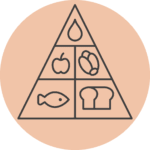
Dietary Causes Of Your Red Cheeks
Yes, certain foods and beverages can make your cheeks turn red. Certain compounds in them can trigger our nerves, which makes our blood vessels get bigger.
15. Alcohol Facial Redness
If alcohol doesn’t agree with you, you may experience red cheeks after drinking. This happens because our bodies produce acetaldehyde when processing alcohol, leading to facial redness.
This reaction is especially common in people of East Asian descent, often due to genetic variations in the ADH1B and ALDH2 genes, which are involved in breaking down acetaldehyde.3
Having a strong redness reaction to alcohol could also indicate rosacea, which often comes with many other symptoms.
Alcohol Facial Redness Symptoms
Symptoms of alcohol-induced red cheeks include:
- Redness that persists after drinking alcohol
- Warmth and flushing of the face
- Itchy or irritated skin
Alcohol Facial Redness Treatment
Treatment options for red cheeks caused by alcohol include:
- Limiting alcohol consumption
- Using antihistamines or allergy medications to counteract the flushing effects
- Consulting a doctor for further evaluation and potential prescription treatments
16. Allergic Reaction to Food
An allergic reaction to certain foods can cause your face to turn red.
Finding out which specific food is causing the reaction can be difficult, but seeing an allergist or a dermatologist who specializes in allergies can help diagnose and manage these reactions.
Food Allergy Symptoms
When our body reacts to certain foods, it can cause redness on the cheeks and itching or swelling.
Food Allergy Treatment
For food allergy treatment, remember these key points:
- Identify and avoid the trigger food. Keeping a food diary and consulting a healthcare professional can help determine the cause of your redness. Always read food labels carefully and inform restaurant staff of your allergies.
- Use antihistamines, available over-the-counter or by prescription, to manage mild symptoms.
- For severe allergies, keep a doctor-prescribed epinephrine auto-injector on hand for emergencies.
17. Spicy Food Sensitivity
There are certain compounds in spicy foods stimulate our central nervous system, which causes our blood vessels to widen and makes our face flushed and red.
Spicy Food Sensitivity Symptoms
If you are sensitive to spicy foods, along with red cheeks, you might also experience sweating and a burning feeling in your mouth. These symptoms can range from minor to severe.
Spicy Food Sensitivity Treatment
While this reaction is generally harmless, it can feel uncomfortable and worrisome. To ease these symptoms, try drinking cold water or milk to cool down the heat in your mouth and reduce redness.
However, if your red cheeks persist or you have other concerning symptoms, see a doctor for further evaluation.
When to See a Medical Doctor or Healthcare Professional for Facial Redness
If you’re concerned about persistent red cheeks, it’s important to consult a doctor.
This redness might be due to common issues like rosacea or food allergies, but it could also indicate more serious conditions, like a virus or autoimmune disease.
A doctor can offer expert advice and help you find the appropriate treatment. Take that first step towards better skin health by seeking professional guidance!
The Role of Gut Health in Skin Disorders
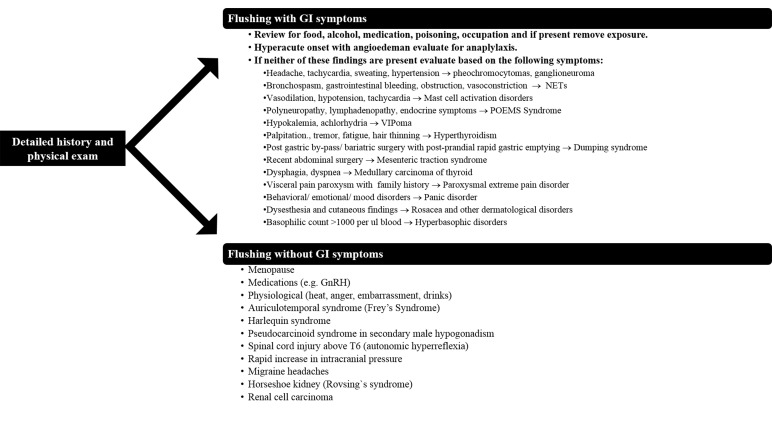
Source: National Library of Medicine & Clinical Medicine and Research 4
In exploring the causes of skin disorders, it’s important to recognize the significant role of gut health.
Many skin conditions, including those resulting in facial redness, are deeply connected to the health of our gastrointestinal tract.5 It’s a two-way street: primary diseases of the gut can cause flushing, while certain external conditions may lead to both flushing and gut-related symptoms. If flushing is accompanied by other gastrointestinal symptoms like headache, syncope, diarrhea, and abdominal pain, an underlying systemic cause should be considered. Understanding this gut-skin connection highlights the importance of a holistic approach to health and skincare, a key focus in nurturing your skin’s well-being.
The Bottom Line:
Solve Your Red Cheek Mystery to Determine How Serious Your Condition Really Is
It’s clear that there are several causes of redness.
But by unraveling the possible reasons behind your rosy cheeks through a spectrum of likely causes and solutions, you gained the ability to distinguish between a minor concern and an urgent health issue.
How powerful is that?!
However, everyone’s skin is unique, so it may take some trial and error to find the most effective treatment for your red cheeks.
Be patient and consistent in your approach, and consult a healthcare professional if you have any concerns.
And if you would like a hand navigating through natural gut-healing solutions, we’re here!
Your journey to a more balanced complexion starts with understanding the root causes and exploring natural treatments.
Transform Your Skin Naturally: Get Started with The Rosacea Method!
FAQs on Red Cheek Causes
What does it mean when your cheeks are red?
Red cheeks can be caused by various factors, including emotional reactions like blushing, extreme temperatures, allergic responses, or medical conditions like rosacea and eczema. Sometimes, they may indicate more serious health issues. If redness persists, consulting a medical professional is advisable for accurate diagnosis.
Why are my cheeks red if I don’t have rosacea?
Red cheeks that are not caused by rosacea can be due to several reasons, such as blushing from emotional responses, reactions to hot or cold temperatures, sunburn, allergies, or other skin conditions. It’s also possible that lifestyle factors, like diet or skincare products, could contribute to redness. Consulting a healthcare provider can help determine the specific cause.
What causes red cheeks as you age?
As you age, red cheeks can be caused by factors like thinning skin, which makes blood vessels more visible, increased sensitivity or dryness of the skin, hormonal changes, or chronic skin conditions like rosacea. Sun damage over the years can also contribute to redness in the cheeks. It’s important to consult a healthcare provider for a precise diagnosis and appropriate treatment.
What is rosy red cheek syndrome?
Rosy red cheek syndrome is not a medically recognized condition. However, persistent redness in the cheeks could be a symptom of various factors, including rosacea, sun exposure, extreme temperatures, or skin sensitivities. For a specific diagnosis and advice on managing red cheeks, it’s recommended to consult with a healthcare professional.
Q: What are 17 common causes of rosy red cheeks?
A: Some common causes of rosy red cheeks include rosacea, sun exposure, emotional stress, spicy foods, caffeine, alcohol, temperature extremes, exercise, certain medications, allergies, lupus, dermatomyositis, Cushing’s syndrome, carcinoid syndrome, seborrheic dermatitis, Crohn’s disease, and certain types of tumors.
Q: What are the available treatments for rosy red cheeks?
A: Treatment options for rosy red cheeks may include topical medications, oral medications, dietary changes, assessing gut health, light therapy, laser therapy, and in some cases, surgical procedures. It is important to consult with a board-certified dermatologist or healthcare professional for a personalized treatment plan.
Q: Can rosy red cheeks be a sign of a serious health condition?
A: In some cases, persistent redness in the cheeks can be a symptom of a serious health condition such as lupus, carcinoid syndrome, Cushing’s syndrome, or certain types of tumors. It is important to seek medical evaluation for persistent or concerning symptoms.
Q: How do I differentiate rosy red cheeks from a common blush?
A: Rosy red cheeks associated with rosacea often involve persistent redness, skin sensitivity, visible blood vessels, and in some cases, acne-like bumps. This differs from a temporary blush, which typically occurs in response to emotional stress, sun exposure, or other triggers and fades relatively quickly.
Q: Are there specific skincare products that can help manage rosy red cheeks?
A: Some skincare products, such as gentle cleansers, moisturizers, and sunscreen formulated for sensitive skin, may help manage rosy red cheeks associated with conditions like rosacea. It is important to look for products labeled as suitable for sensitive or rosacea-prone skin.
Q: What are the potential risks of leaving rosy red cheeks untreated?
A: Untreated rosy red cheeks, especially those associated with conditions like rosacea, may lead to worsening of symptoms, potential flare-ups, and impacts on emotional well-being. Seeking appropriate medical attention can help minimize these risks.
Q: Can rosy red cheeks turn into a more severe skin condition over time?
A: In some cases, untreated rosy red cheeks associated with conditions like rosacea may progress to more severe manifestations such as persistent redness, visible blood vessels, and acne-like bumps. Early intervention can help prevent such progression.
Q: Can certain food or drink intolerances contribute to rosy red cheeks?
A: Some individuals may experience flare-ups of rosy red cheeks due to food or drink intolerances, such as spicy foods, caffeine, or alcohol. Identifying and avoiding trigger foods and beverages may help manage symptoms in such cases.
Resources:
- Dessinioti, Clio, and Christina Antoniou. “The ‘Red Face’: Not Always Rosacea.” Clinics in Dermatology, vol. 35, no. 2, 2017, pp. 201-206. ScienceDirect, https://doi.org/10.1016/j.clindermatol.2016.10.015. ↩︎
- The flushing patient: Differential diagnosis, workup, and treatment
Izikson, Leonid et al. Journal of the American Academy of Dermatology, Volume 55, Issue 2, 193 – 208 ↩︎ - Alexandra Hamada, Han Guel Jung, Karl Orozco & Greggor Mattson (2022) Anticipated Stigma and Self-Racialization: From Alcohol Flush Reaction to Panethnic Asian Glow, Deviant Behavior, 43:8, 976-990, DOI: 10.1080/01639625.2021.1947759 ↩︎
- Rastogi V, Singh D, Mazza JJ, Parajuli D, Yale SH. Flushing Disorders Associated with Gastrointestinal Symptoms: Part 1, Neuroendocrine Tumors, Mast Cell Disorders and Hyperbasophila. Clin Med Res. 2018 Jun;16(1-2):16-28. doi: 10.3121/cmr.2017.1379a. Epub 2018 Apr 12. PMID: 29650525; PMCID: PMC6108509. ↩︎
- Rastogi V, Singh D, Mazza JJ, Parajuli D, Yale SH. Flushing Disorders Associated with Gastrointestinal Symptoms: Part 1, Neuroendocrine Tumors, Mast Cell Disorders and Hyperbasophila. Clin Med Res. 2018 Jun;16(1-2):16-28. doi: 10.3121/cmr.2017.1379a. Epub 2018 Apr 12. PMID: 29650525; PMCID: PMC6108509. ↩︎
MEDICAL DISCLAIMER
This content is for informational and educational purposes only. It is not intended to provide medical advice or to take the place of such advice or treatment from a personal physician. All readers/viewers of this content are advised to consult their doctors or qualified health professionals regarding specific health questions. Neither Dr. Tara O’Desky nor the publisher of this content takes responsibility for possible health consequences of any person or persons reading or following the information in this educational content. All viewers of this content, especially those taking prescription or over-the-counter medications, should consult their physicians before beginning any nutrition, supplement or lifestyle program.
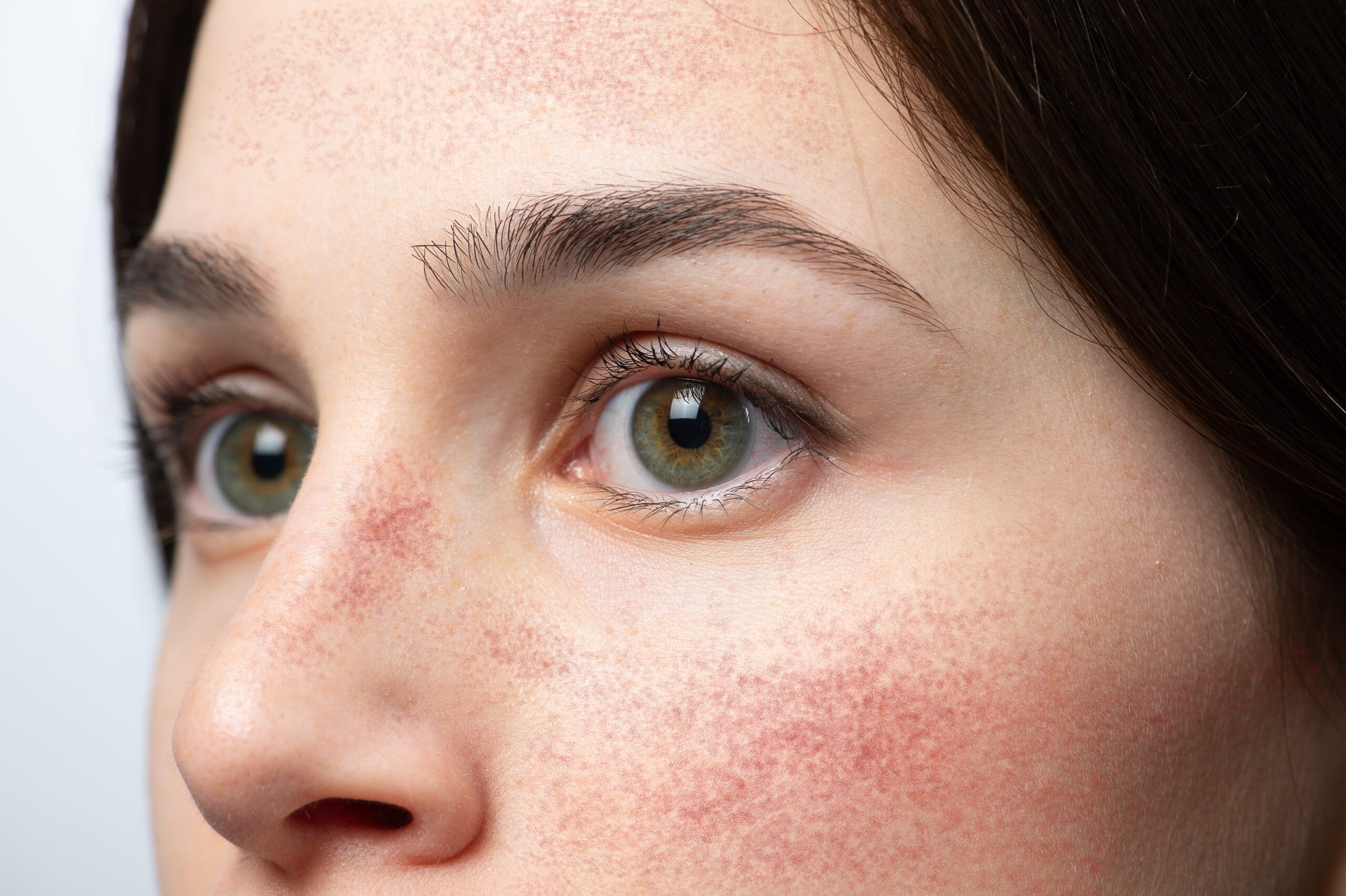
Leave a Reply
Learn More About Me
20 years of rosacea
- rosacea
- chronic skin issues
- gut issues
- food sensitivities
- inflammatory conditions
After 20 years of ineffective treatments and medications, Dr. O'Desky reversed her rosacea 100% through dietary changes and food-based medicine.
Health Coach & Holistic Skin Expert
Meet
Dr. Tara O'Desky
Since developing her own holistic healing program,
The Rosacea Method, she has helped countless patients of all ages with:
- rosacea
- chronic skin issues
- gut health
- food sensitivities
- inflammatory conditions
Dr. O'Desky continues to see patients in private practice in the USA and also sees clients via Telehealth. She currently offers various programs and workshops for people all over the world dealing with chronic health issues, poor gut health, and rosacea.
Health Coach and Holistic Skin Expert
Meet Dr. Tara O'Desky
-L. M.
"I want to say thank you so much for the program!
I never feel hungry anymore. My diet has opened up a ton and I feel really healthy and excited learning that there’s so many things I can eat now that are healthy and tasty. I felt good through the entire cleanse and my skin has definitely improved."
-Anonymous
"I felt so hopeless and I could not see light at the end of the tunnel. Now I have hope again and I feel more positive about my situation overall! Yes it can definitely heal, I have so so sure others heal! This program is great, I feel like It covers everything! Thank you! "
-Darlene B
"For the first time in 6 years, I feel like I have been given a clear direction to go in that will actually heal my skin. There's so much guess work that comes along with skin complications and Tara helps to clear all that up.Recommend 1000%."
This helped me so much because I wasn’t sure if I had Rosacea or something else. Thank you Dr. Tara!
Yes it often looks like other skin conditions, so it’s always best to get a correct diagnosis from your dermatologist!
Keeping a food diary has helped me tremendously 🙏🙌🤍 I’m nowhere near where I’d like to be but hoping I can keep using your tools to get there one day at a time
Absolutely!
What home devices can be used for spider veins on face
Spider veins are usually visible due to increased inflammation, and for many of us who successfully reverse rosacea, these veins are no longer visible. If you’re looking for home devices such as red light therapy masks, the reviews are mixed but some do find them helpful.
There are so many different types, causes, and diseases that are assoicated with rosacea. The infomation is overwhelming. I’ve struggled with rosy cheeks since childhood and now I have very visible spider veins on my cheeks and nose. This article is very informative and organized. I’m starting to realize that healing is much more complex than I originally thought.
Healing does take time, but it’s completely within reach! In my program I give you clear steps and it’s not overwhelming, just a commitment!
Thank you for this insightful information, I am really struggling with my self confidence due to my rosacea on my cheek. Reading this post has been extremely useful.
I’m so glad it’s helpful!
I’ve had rosacea since I was 20 (now 36) but never officially diagnosed as I assumed I knew what it was. It probably would be wise to get an official diagnosis- I just hope they don’t insist on throwing a lot of medications at me
Good luck with that LOL!!!
Happy birthday!! That cake looks amazing. I am lactose intolerant and figuring that out has really helped with my rosacea. I do add lacteeze if I need to cheat!
Most people are lactose intolerant and have no idea! Reducing it can be very helpful!
I’ve had rosacea for almost 3 years now. I never get up and down days everyday my skin is and has been the same. I have type 1&2… its a struggle. I’m going to start following your advice. Thank you
Great article. My skin started drastically changing after doing birth control pill for 9 months, and now I am trying anything/everything to heal. 😩. I would love to get in your program and figure out how to do it without medications and creams.
yes, sadly the pill has many side effects that they don’t tell you about. I’m glad you are taking a holistic approach!
I love your content very much and I want to subscribe because I will get married soon and I am very afraid of the redness of my face and I am afraid to go out in the sun. I spent a lot of money on lasers and doctors and there is no result. I hope you choose me so that we can start treatment in the right way
Unfortunately, lasers and doctor visits rarely address what’s going on internally! I’m so glad you found my page!
Been struggling with Rosacea for 20years and nothing has ever really worked. Would love to give a holistic approach a go as I believe this condition should be cured from the inside.
Yes it should be, and hopefully that will be the typical treatment in the future. And I had rosacea for 20 years too! This is your lucky year!
Interesting read .. especially the information about how chicken pox play a role for some people
Yes! Dormant viruses play a key role in your overall health.
This was so informative. I appreciate how well-researched and thoughtful you are! I’ve been struggling with rosacea for years and have tried everything without success. Learning about the gut-skin connection was espeically eye-opening, and I’m hopeful this might lead to some relief.
Oh it absolutely will! So happy you’ve found me!
Hi.
if we had chicken pot at age 7, this could mean the virus is still dormant? or are we already inmune to it since our body healed already at that age?
It’s dormant, and can reappear later as a different variant such as shingles.
Thank you for always posting helpful content, as a person with rosecea, is always so frustrating to have skin condition like this. I agree that it has to do with gut health for sure!
Thank you for all the information you share! I have already tried a lot with a therapist like pro biotics and hormonal supplements, but unfortunately I still have rosacea. Would love to win your program!
Love from the Netherlands 🇳🇱
Thank you for always providing such detailed content! I’ve learnt more on your pages than I have in all my derm appointments combined !
You’re very welcome! Happy to help!
Thank you for all the information you share! I’ve learnt so much from following you & it’s great to have finally found someone who understands rosacea.